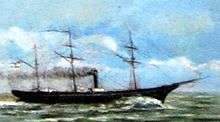ARA Paraná (1874)
 Steam gunboat ARA Paraná, circa 1874 | |
| History | |
|---|---|
| Name: | Paraná |
| Namesake: | the Paraná river |
| Ordered: | 1872 |
| Builder: | Laird Brothers, Birkenhead, United Kingdom |
| Laid down: | 1873 |
| Launched: | 1873 |
| Completed: | 1874 |
| Commissioned: | 1874 |
| Out of service: | 1900 |
| Fate: | Converted to transport and renamed Piedrabuena; wrecked in 1926. |
| General characteristics | |
| Type: | steam and sail corvette, armed as gunboat |
| Displacement: | 550 tons |
| Length: | 4,636 m (15,210.0 ft) |
| Beam: | 763 m (2,503.3 ft) |
| Draft: | 54 m (177 ft) |
| Propulsion: | 1-shaft compound steam engine, 475 ihp (354 kW), 2 cylindrical boilers, 90 tons coal |
| Sail plan: | Barque |
| Speed: | 11 knots (13 mph; 20 km/h) under sail and steam |
| Complement: | 114 (14 officers, 100 crew) |
| Armament: |
|
ARA Paraná was a steam and sail corvette built in United Kingdom in 1873 which served as a gunboat with the Argentine Navy between 1874 and 1899. It was decommissioned in 1900, converted to a transport and renamed Piedrabuena.
It was the sixth ship of the Argentine Navy named after the Paraná river; its name was chosen by President Sarmiento. [1]
Design
Paraná was a steam corvette rigged as a barque, with a steel hull covered in wood planks. She was powered by a 475 HP compound steam engine with two cylindrical boilers, driving a 2-paddle Bevis-type propeller. It could reach a speed of 11 knots (13 mph; 20 km/h) under sail and steam, or 10 knots (12 mph; 19 km/h) under steam only. [1]
Her main battery, as built, was composed of four Vavasseur mounted 7 in (177.8 mm) guns, mounted one at the front of the funnel, another behind it, and one per side. [1] As refitted in 1879, it included one 150 mm (5.9 in) (bow) and two 90 mm (3.5 in) (one per side) Armstrong guns. [n 2]
History
Paraná was ordered in 1872 as part of the so-called “Sarmiento’s Squadron”, authorized by the Naval Law of 1872 to enhance the Argentine Navy after its performance in the Paraguayan War. Construction was contracted at a cost of £ 32,000 to the shipyard of Laird Brothers, at Birkenhead; together with her sister ship Uruguay. [2]
She was ferried to Argentina by a British crew, departing Birkenhead in April 1874 and arriving in Buenos Aires at the end of that month; being commissioned into the Argentine Navy on 2 May 1874. Her first commander was Sargento Mayor de Marina Ceferino Ramírez, who was removed from its command when the crew joins the September 1874 Revolution. After the failure of the revolution, Paraná was surrendered in the Uruguayan port of Maldonado, and returned to Argentina in late November 1874. [1] [3]
Between 1876 and 1877 Paraná is assigned to Asunción del Paraguay, commanded by Captain Augusto Lasserre. From 1878 to 1884 she sails several times to the Patagonia, with a trip to Río de Janeiro in July-December 1882. In 1879 she is refurbished, including changing her armament. Between April and November 1884 she participates in the Argentine expedition to the South Atlantic to implement the Boundary Treaty of 1881, which concluded with the possession of Ushuaia on 12 October. She returned to Buenos Aires in late November 1884. [1]
From 1885 to 1889 she performs various tasks in the Paraná, Uruguay and de la Plata rivers, including hydrographic survey. [1]
In 1894 she is repaired and modernized, including replacement of the boilers. During 1895, 1897 and 1898 is assigned to transport duties; and in 1899 is disarmed. In 1900 she is transformed to transport ship, reclassified, and renamed Piedrabuena. [1]
Footnotes
References
Notes
- 1 2 3 4 5 6 7 "CAÑONERA ARA PARANA (1872)". Histarmar - Historia y Arqueología Marítima (in Spanish). Retrieved 2015-12-31.
- ↑ "LA ESCUADRA DE SARMIENTO (1872)". Histarmar - Historia y Arqueología Marítima (in Spanish). Retrieved 2015-12-31.
- ↑ "THE ARGENTINE REPUBLIC. THE REVOLUTIONISTS SURRENDER THE GUNBOAT PARANA. THE MAILS FOR EUROPE STOPPED.". The New York Times. New York, USA. 22 November 1874. Retrieved 2015-12-31.
Bibliography
- Arguindeguy, Pablo E.; Rodríguez, Horacio (1999). Buques de la Armada Argentina 1852-1899 sus comandos y operaciones (in Spanish). Buenos Aires: Instituto Nacional Browniano.
See also
Further reading
- Arguindeguy, Pablo (1972). Apuntes sobre los buques de la Armada Argentina (1810-1970) (in Spanish). Buenos Aires, Argentina: Comando en Jefe de la Armada.
- Burzio, Humberto (1960). Armada Nacional (in Spanish). Secretaria de Estado de Marina.
- Caillet-Bois, Teodoro (1944). Historia Naval Argentina (in Spanish). Buenos Aires: Imprenta López.
External links
- "CAÑONERA ARA PARANA (1872)" [Gunboat “Paraná” (1872)]. Histarmar - Historia y Arqueología Marítima (in Spanish). Argentina: Fundación Histarmar. Retrieved 2015-12-30.
- "LA ESCUADRA DE SARMIENTO (1872)" [Sarmiento’s Squadron (1872)]. Histarmar - Historia y Arqueología Marítima (in Spanish). Argentina: Fundación Histarmar. Retrieved 2015-12-30.
